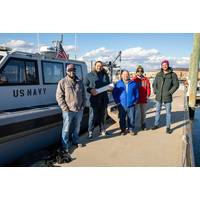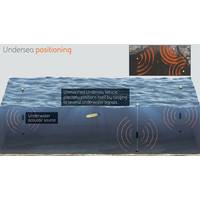
Manta Ray UUV Prototype Completes In-water Testing
The Manta Ray prototype uncrewed underwater vehicle (UUV) built by Northrop Grumman completed full-scale, in-water testing off the coast of Southern California in February and March 2024. Manta Ray was built through a Defense Advanced Research Projects Agency (DARPA) program aimed at advancing key technologies to benefit future UUV designs, including techniques to manage energy, increased payload capacity, low-power propulsion and more.The recent in-water testing demonstrated at-sea hydrodynamic performance, including submerged operations using all the vehicle’s modes of propulsion and

Bionet Sonar Tests Underwater Wireless Network at NUWC Division Newport
through a secure channel. During the two days of testing, the team was able to collect the data needed to move their project forward.“The results were fantastic,” Demirors said. “Everything was functioning as it should be.”The HydroNet project is funded by the Defense Advanced Research Projects Agency (DARPA) through the Small Business Innovation Research (SBIR) and Small Business Technology Transfer programs, which encourage small businesses to engage in government research and development with the potential for commercialization.“We are extremely pleased about this partnership

DARPA Funds Tech to better Detect Whales
Charles River Analytics won a $1.5 million follow-on contract from the Defense Advanced Research Projects Agency (DARPA) to develop a multi-sensor fusion module that incorporates deep learning to autonomously and accurately detect whales and other aquatic mammals.To protect marine mammals from collisions and sonar exposure, sailors must keep a vigilant lookout. Operators of remotely operated vehicles must also stay alert, and uncrewed surface vehicles’ (USVs) currently limited and narrow video feeds create risk, too. To reduce the strain on human lookouts, and give USVs the ability to steer clear

Sonardyne Suite for Dive Technologies’ AUV
Technologies of Quincy, Mass., selected a suite of Sonardyne technologies for navigation, tracking and control of its large displacement DIVE-LD autonomous underwater vehicle (AUV) program.Founded in 2018, Dive Technologies’ rapid development program has included support from the Defense Advanced Research Projects Agency (DARPA) and technology partnerships with organizations including the Center for Marine Autonomy and Robotics at Virginia Tech. A key part of the development has been to opt for high-performance, off-the-shelf systems for its DIVE-LD AUV, a 19-ft. long, 48-in. diameter vehicle designed

Xerox and DARPA Partner to Develop IoT Ocean Sensors
PARC, a Xerox company, announced Thursday it has been awarded a contract by the U.S.' Defense Advanced Research Projects Agency (DARPA) for the next development phase in the Ocean of Things, a project to expand what scientists know about the seas.Initially announced by DARPA in 2017, the Ocean of Things project is deploying small, low-cost drifters in the Southern California Bight and Gulf of Mexico to collect data on the environment and human impact. This includes sea surface temperature, sea state, surface activities and even information on marine life moving through the area.“Oceans cover

Gibbs & Cox to Develop 'Sea Train' Concept
Naval architecture firm Gibbs & Cox said it has been awarded a multi-phase contract from the U.S.' Defense Advanced Research Projects Agency (DARPA) to develop and demonstrate a connectorless "Sea Train" concept.DARPA's Sea Train program aims to demonstrate long range deployment capabilities for a distributed fleet of tactical unmanned surface vessels. The program seeks to enable extended transoceanic transit and long-range naval operations by exploiting the efficiencies of a system of connected vessels.The goal is to develop and demonstrate approaches that exploit wave-making
Anti-Submarine Warfare: Unmanned Future
or standalone capability for ASW is just beginning to emerge. One example is the ACTUV, a 40-meter long-endurance unmanned ASW platform being developed by DARPA and ONR in the U.S.” The ASW Continuous Trail Unmanned Vessel (ACTUV) is an unmanned vessel designed by the Defense Advanced Research Projects Agency (DARPA). The state-of-the-art vessel is built specifically to track quiet diesel-electric submarines, at a fraction of their size and cost. The project also seeks to advance unmanned system autonomy so that maritime operators are able to deploy platforms capable of crossing

US Navy Seeks Improved Undersea Capabilities
Undersea navigation and positioning system development to begin for U.S. Navy BAE Systems informs it has been selected by the U.S. Defense Advanced Research Projects Agency (DARPA) to develop an undersea navigation system aimed at enhancing the U.S. Navy’s ability to provide precise, global positioning throughout the ocean basins. The contract will support a program called the Positioning System for Deep Ocean Navigation (POSYDON), which seeks to allow undersea vehicles to accurately navigate while remaining below the ocean’s surface. POSYDON aims to replace
A New Age for Underwater Autonomy
and similar infrastructure.” Acknowledgements Professor Brian Williams, of aeronautics and astronautics at MIT This research was funded in part by Schmidt Ocean Sciences. The underlying technology was supported in part by Boeing Co., the Keck Institute of Space Sciences, the Defense Advanced Research Projects Agency, and NASA. Correction: several of the images used in this story were shared by researchers and should have been attributed to Schmidt Ocean Institute, a participant in the R/V Falkor expedition. (As published in the June 2015 edition of Marine Technology Reporter - http://www

 December 2025
December 2025





